Years ago, when I had first hired Mr. Cross to address my messes in the detective office, attend to telephone calls and handle my mailings and such, he placed an opened, pale blue envelope on the ol’ tanker in a la-de-da manner. With reservations, as if he were setting me up, I slid the letter out of the folding with a sigh and airily glanced down at the words before me. I read and I read and my eyes must have sharpened with growing obsession, for this wasn’t one of Mr. Cross’s tricks.
“I love your blog and find the same intrigue with the many ‘mysterious’ houses and buildings in Omaha. I wish I had the time to do the research you do but since I cannot, I wonder if you would look into this one? I have lots more on my curiosity list but this is one you might not know about. If you do, I apologize. There was a film made in 1948, Mr. Blandings Builds His Dream House. As a promotion for the film, the studio built 73 ‘dream houses’ in various locations in the United States, selling some of them by raffle; over 60 of the houses were equipped by General Electric, including one in Omaha. My mother would tell us every time we drove by the house on the northwest corner of 72nd Ave and Cass Street about this fact and she knew the family who lived there. Through the years the house has undergone little change apart from some deterioration.
I think there is a good story there. If you would like more information, please feel free to contact me. Go for it!
Thanks for the interesting fun you provide.
Barb Naughtin”
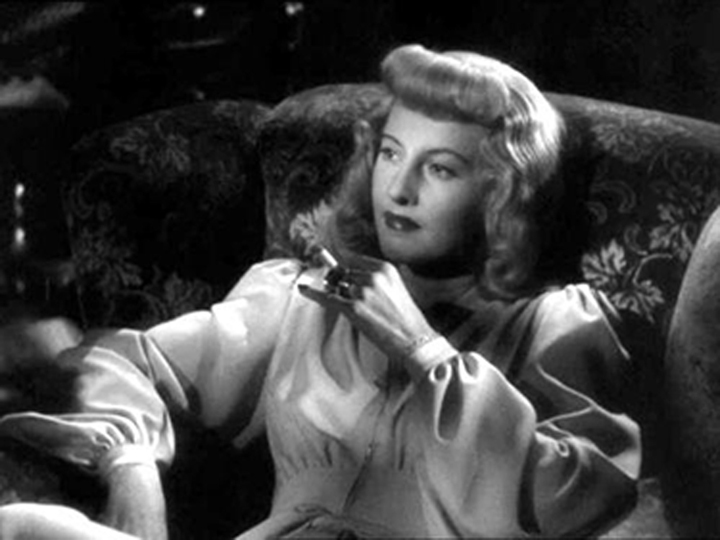
I was beside myself with the generosity, mysterious nature and intrigue of this letter. Although I had seen the movie, I knew nothing of this promotion and the idea that Omaha was hostess to one of these Dream Houses gave me a stirring delight! I immediately wrote Ms. Naughtin, never to be heard from again…which always give pause. Where did she go? Who was she? I began a preliminary search on the property, just to make sure there wasn’t anything hinky in Ms. Naughtin’s story line. A-Okay on the factual side of things but my sleuthing mission went cold, truthbetold, and got buried like so many other of my barely scratched architectural files around here. I do hope Ms. Naughtin does not mind me sharing this correspondence with all of you at this late juncture. And maybe her story is not over, after all.
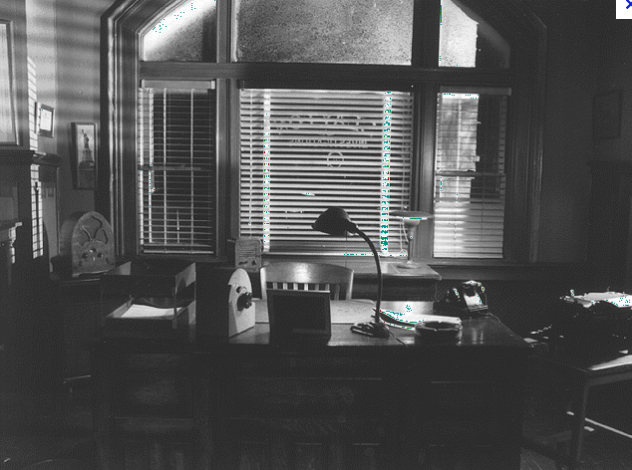
So imagine my surprise when just the other day I heard from the newest owner of This Very Mr. Blandings Omaha Dream House. You can’t make this sort of thing up. I recognize this is a trite-ism peddled by just the sort of detective who very much likes to make things up, but this is one tall tale, I did not fabricate.
Once again an envelope and its contents were left slit open on my desk a few mornings ago. It read:
“Mr. Blandings Builds His Dream House 1946 to 2020 remake of a classic home. One of a handful left of the replica houses film studio built to promote the black and white movie staring Cary Grant. Located at 502 N 72nd Ave this home is closing in on its one-year make over. Great care is being taken to keep as much original as possible while still bringing it into the 21st century. I would love to show you around.
Lori”
My Guinness! Was this message meant to hook me in or what? It worked. Lori was Lori Krejci of “Design Matters” Transformation Realty LLC. Not intending to live in the home, she had purchased the 72nd Avenue house without knowing about the famous movie or the story. I imagine very soon the house will be up for sale again, which might have been the purpose of the invitation. Unfortunately for us, her “realtor or someone else” had proffered the story out to the World-Herald as well. Apparently there is another story coming out about Lori’s rehab to include photos. For that reason, I will fixate on my previous digging, my research and allow my mind to roam in directions the World-Herald most likely will not be covering. Oh, I do hope we can fall in a few tangly holes along the way. This will be a relatively short excavation by our obsessive standards but perhaps my discoveries can serve to historically enhance a future piece about Lori’s renovation.

A Brief History of Mr. Blandings Builds His Dream House
If you’ve been around the block with us in these sleuthing matters, you already know that I actually live for older movies, an attractive habit I inherited from my mother and grandmother. Although I love Cary Grant, Mr. Blandings Builds His Dream Home is not my all-time favorite vehicle of his. The comedy was based off an April 1946 article written by Eric Hodgins for Fortune magazine; then Hodgins followed with a bestselling novel, which is really entertaining and good writing, in my estimation.
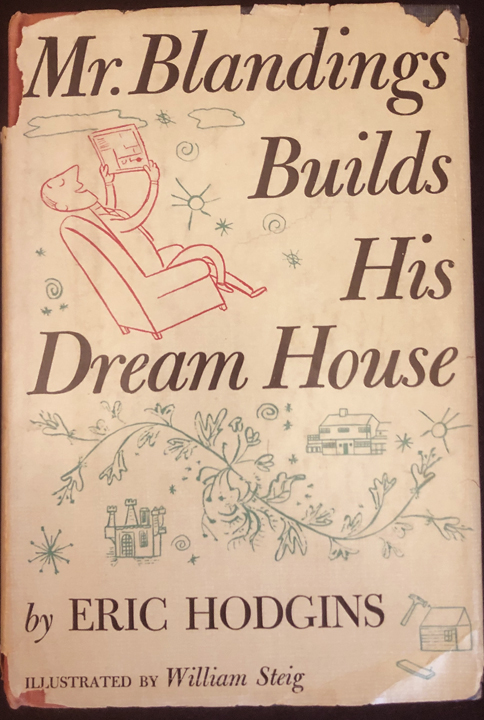
New York: Simon and Schuster, 1946. First Edition. Great cover!
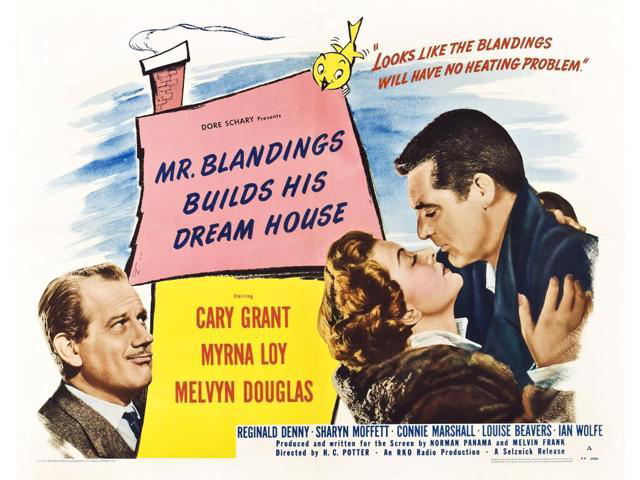
One of many movie posters designed for Mr. Blandings Builds His Dream House. The comedy came later in 1948, starring Cary Grant, Myrna Loy, and Melvyn Douglas. A well-loved, hit movie, I might be the only one in the States who is still leery about this Melvyn Douglas character.
Quick Plot: Mr. Blandings and his family want to leave their “cramped” Manhattan apartment for “the old Hackett Place” in remote Connecticut country. They ultimately tear down the two hundred year old house (I didn’t like that part), deciding to design and build a beautiful Colonial Revival in its place. Lotsa hijinks, until the structure is eventually standing and everyone is happy.
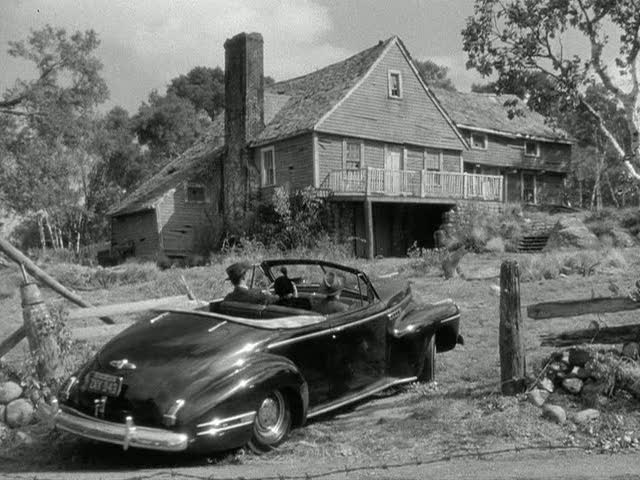
“The old Hackett Place,” which I adored a much as the Blandings, is regrettably torn down because it cannot be fixed. Poppycock!
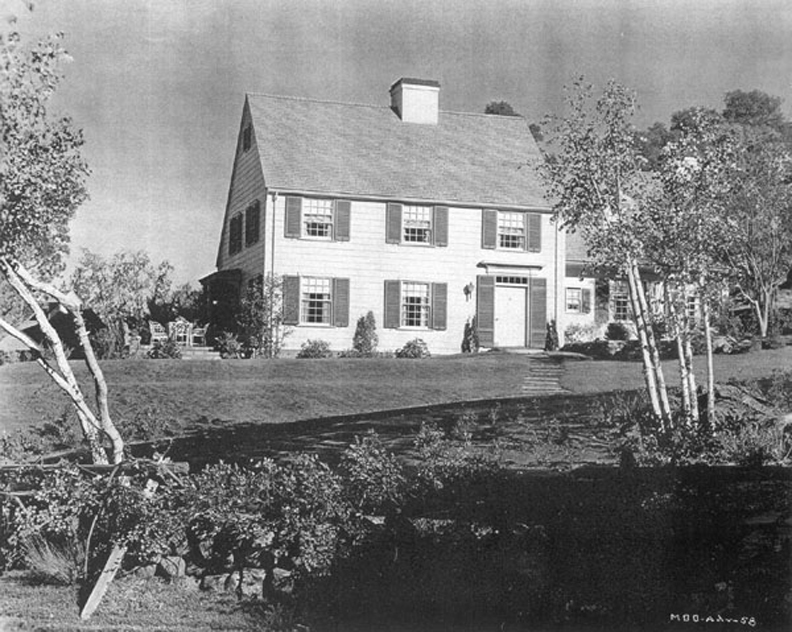
Fresh, new, perfect Colonial is built for the family to start anew.
Yes, the comedy is somewhat amusing in places and I adored the interiors and exterior set design. We just rewatched it so I could get reacquainted for this investigation and I probably would have enjoyed it a lot more if it weren’t for Mr. Cassette’s Loud Eye Rolling and Frequent Throat Clearing and Loud Snorts. For myself, I found the questionable, old boyfriend and the understandably jealous Cary Grant to be quite weird and uncomfortable in an undeveloped way and let’s be honest—everyone knows by now what is meant by placement of a terrible rainstorm in an older movie. And I am charmed by Myrna Loy but why was she so absent? Puuuulease. Cary had every reason to be paranoid.

But maybe that is the point or beside the point and who cares anyhoo? What is even more interesting about the movie is that production company, RKO Radio Pictures and specifically who distributed it, the Selznick Releasing Organization, spearheaded one of the cleverest marketing campaigns of all time. This, according to Miss Cassette and those who dream of houses.
The Marketing Scheme
American film producer, screenwriter and film studio executive, David O. Selznick along with his public relations man, Paul Macnamara, devised a plan to promote the Mr. Blandings movie. They would build replicas of the Dream Home and raffle them the night of the premiere in each major city. They initially intended to build 100 houses. Previous to the movie’s release, the publicity department of RKO delivered architect’s blueprints of a four-bedroom Colonial Revival to local builders across the country, “asking that they build houses as near to the specifications of the movie house as conditions would permit.” Builders were allowed quite a bit of freedom, it would appear. Ultimately 73 Dream Houses were completed. I never knew about any of this until researching this story after reading Barb’s letter!
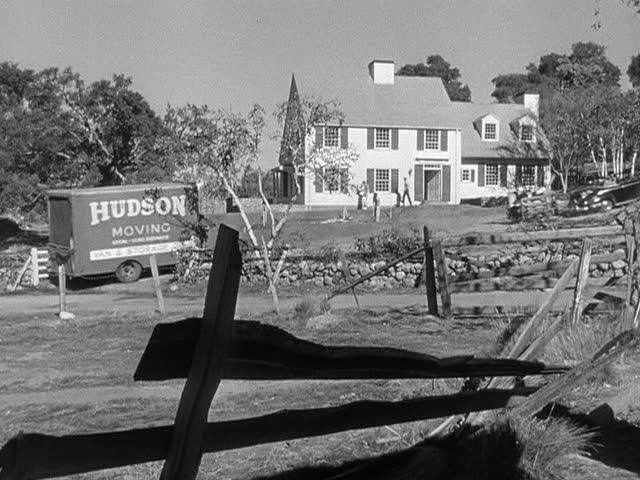
The Blandings move into their Dream House. Still from the movie.
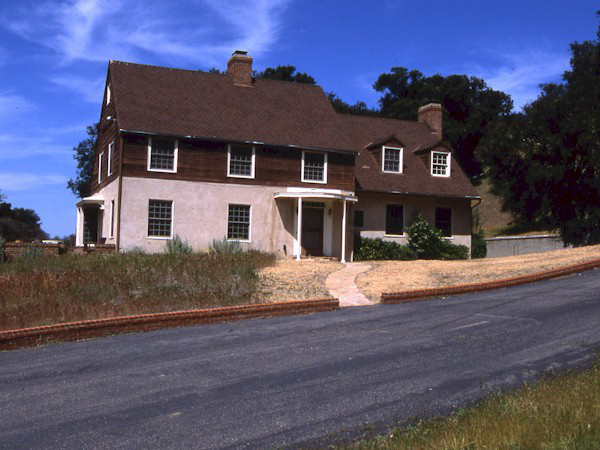
The original house built for the 1948 comedy, apparently still stands on the now retired Fox Ranch property. Although she has endured a number of facelifts, she is located in Malibu Creek State Park in the hills and is now utilized as the State Park office.
Selznick reportedly involved General Electric in this promotion, allowing them to showcase their newest appliances in the dream home kitchens, included in 60 of the final structures. Local businesses, products outfitted by local suppliers, contractors and workers contributed to the building of these houses. There was a lot of local advertising and once completed, The Blandings Dream Houses were opened for tours. All of the homes were then sold by raffle or lottery. Coincidentally one researcher pointed out that these Dream Homes were often positioned on a corner lot, composed to draw in prospective homeowners to a particular subdivision. I believe this is the case with Omaha’s Dream House. More on that later.

Selznick’s promotion also lent itself to other marketing campaigns, such as this Kellogg’s dollhouse. This poster was used as a promotional tie-in with the film. Kellogg’s offered full color scale model kits of the house featured in Mr. Blandings Builds His Dream House for only 35 cents and a box top. This dollhouse is just the sort of offering that made Miss Cassette into Miss Cassette. Sketch plans, even!
The Dream House Replicas
I will say, some replicas I spied resembled the Blandings’ home and others did not. It was so interesting. (For the record, I only included images of the Colonial style.) Below is a list of cities where Dream Houses are located, for those OBSESSIVES in our midst.
Phoenix, Little Rock, Bakersfield, Fresno, Oakland, Sacramento, San Diego, San Francisco, Denver, Bridgeport, Hartford, Washington, Atlanta, Chicago, Indianapolis, South Bend, Terre Haute, Des Moines, Louisville, Baltimore, Worcester, Detroit, Grand Rapids, St. Paul, Kansas City, St. Louis, Omaha, Tenafly, Albuquerque, Albany, Buffalo, Rochester, Syracuse, Tarrytown, Utica, Greensboro, Rocky Mount, Cleveland, Columbus, Toledo, Oklahoma City, Tulsa, Cedar Hills, Philadelphia, Pittsburgh, Providence, Chattanooga, Memphis, Nashville, Amarillo, Austin, Dallas, Fort Worth, Houston, Salt Lake City, Seattle, and Spokane.
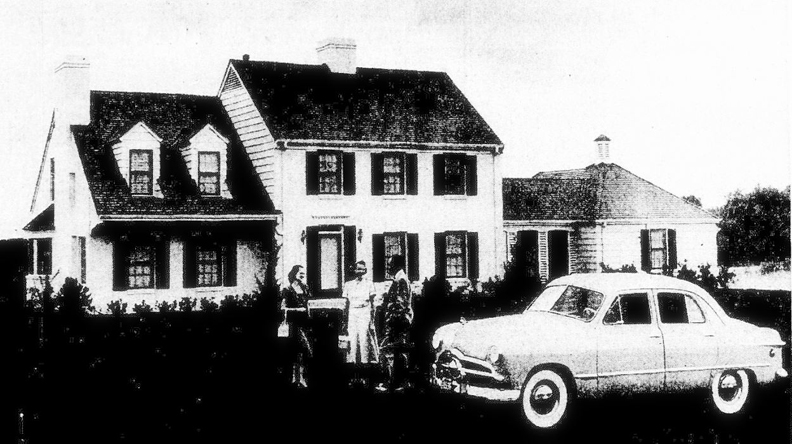
The Dallas, Texas Blandings House.

All raffle proceeds of the Portland, Oregon Blandings’ house went to the Heart Association.
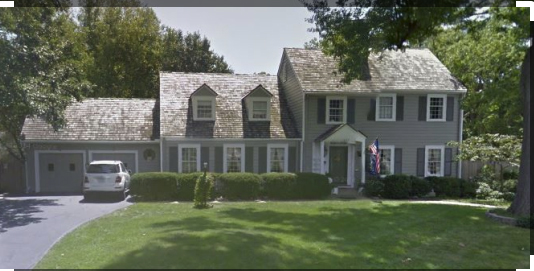
Kansas City, Missouri maintains a very pretty model.

Thousands lined up in front of the house in Ottawa Hills, Ohio paying admission to view the house at its opening. Great Photo. Look at the gentlemen on the roof with “B” pennant flags.
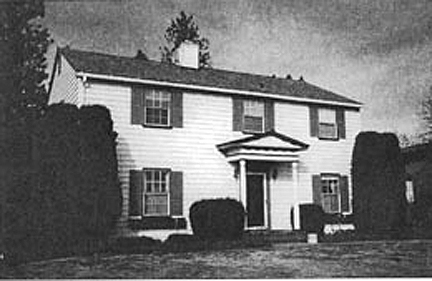
The West Haven, Connecticut Blandings’ House.

The perfect Nashville, Tennessee advertisement for their Blandings’ replica.
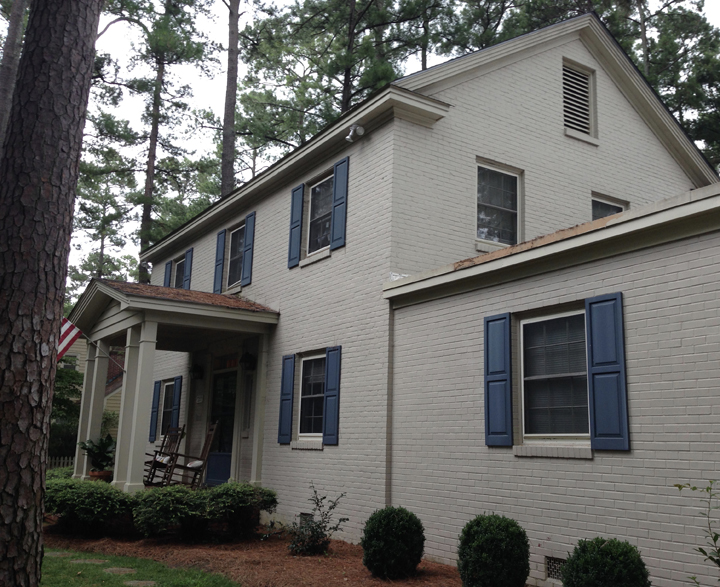
The Rocky Mount, North Carolina home is in A+ condition.
Origins of the Blandings’ Omaha House
Early on, I discovered our 502 North 72nd Avenue on the Douglas County Assessor’s site, legally listed as Underwood Hills, Lot 10, Block 3.
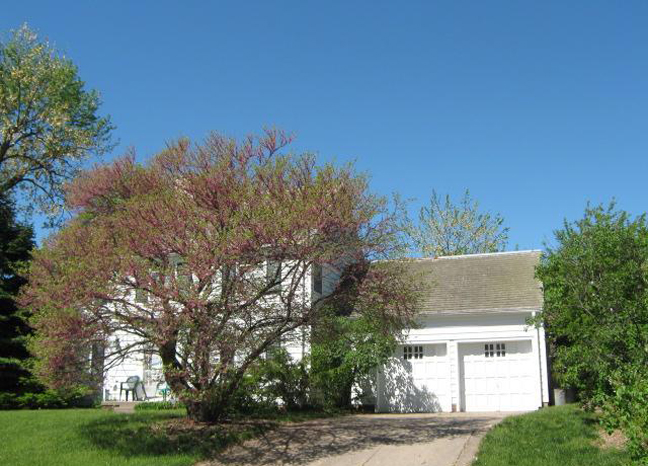
Douglas County Assessor photo of the Blandings’ modest Omaha replica from 2010. I was so happy.
After many drive-throughs and sniff-outs, I surmised Underwood Hills to be a small, attractive, well-laid addition with great cohesion. It is located on the northwest intersection of 72nd and Cass-Underwood Avenue. All of the properties lend to the wholeness of its post-war glory. The streets, a mix of both straight city grid and curved, subdivision wanderings, contribute to the seamless flow. There is even a hidden cul de sac in the top northwest corner of the plat. It is fun to drive around these blocks but by the amount of people out walking, it is surely more entertaining by foot. Mostly ranch type homes with a few Colonials sprinkled in, I love the gently rolling lots and easy on the eyes landscaping. The area reminds be of the additions surrounding Countryside Village, but with a close-knit, welcoming, Midtown feel.

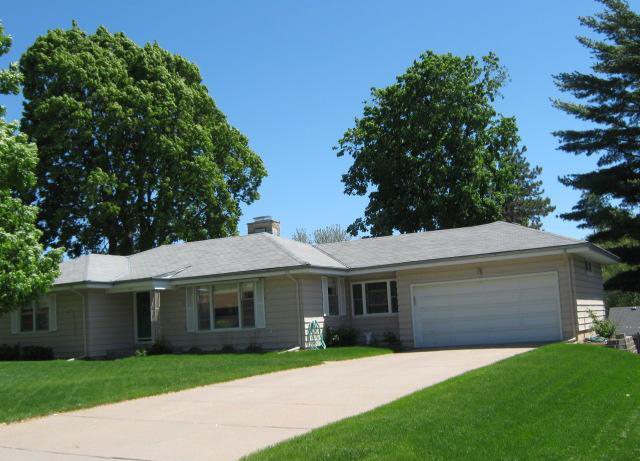
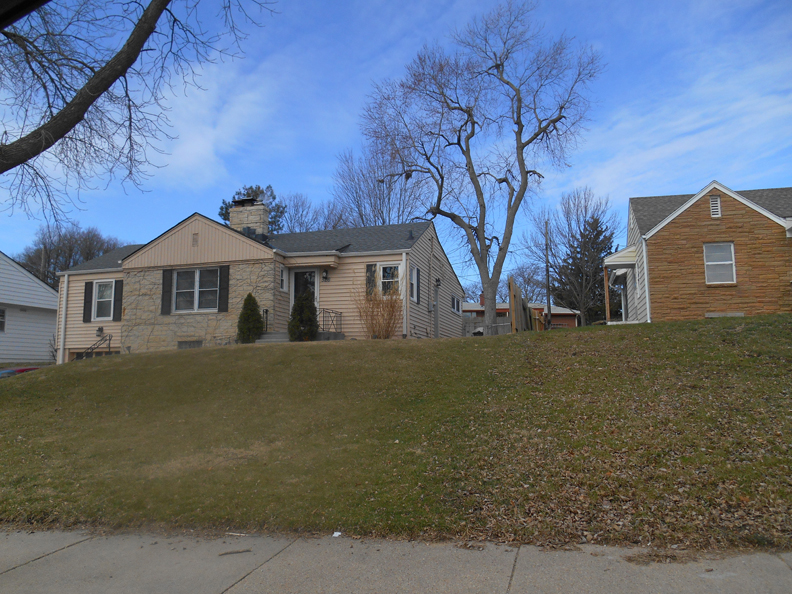
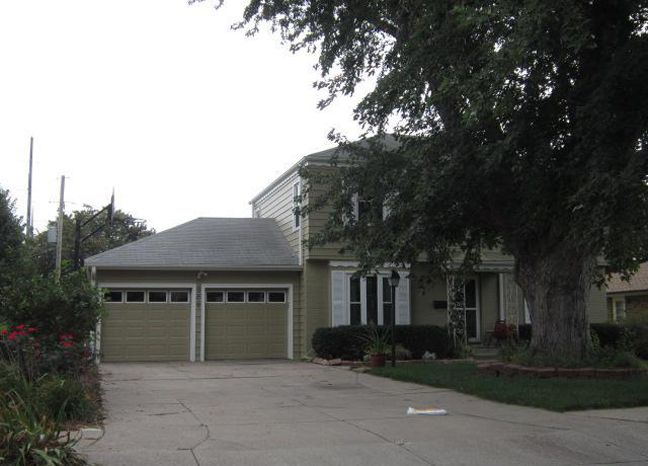
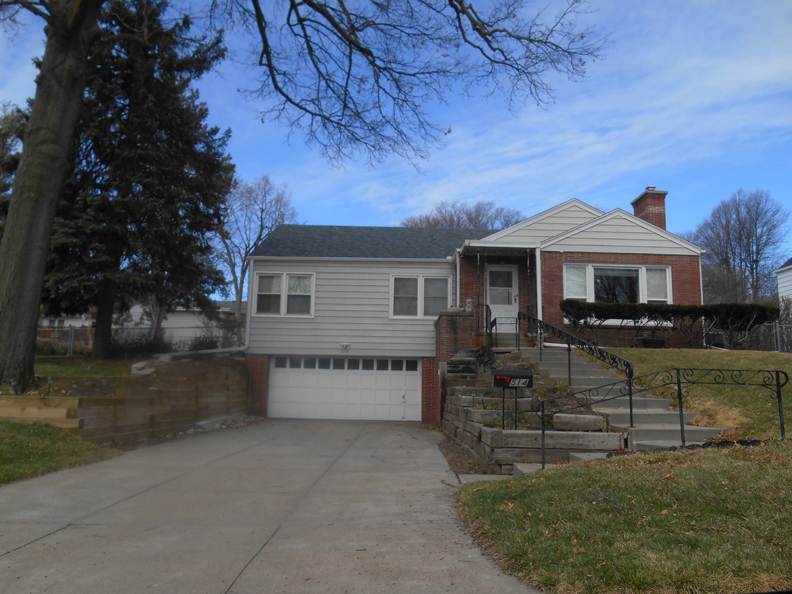
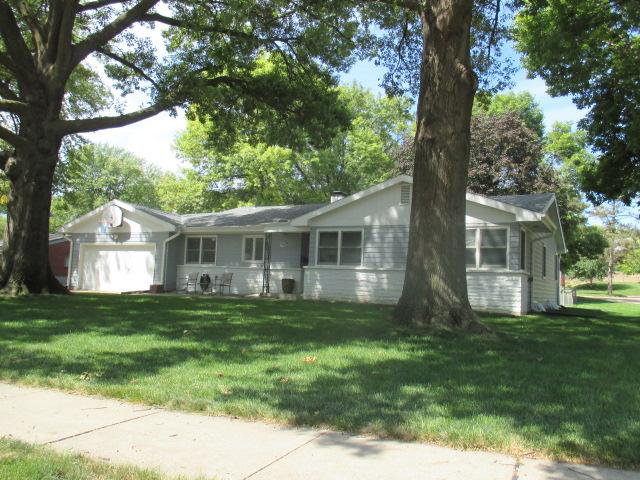

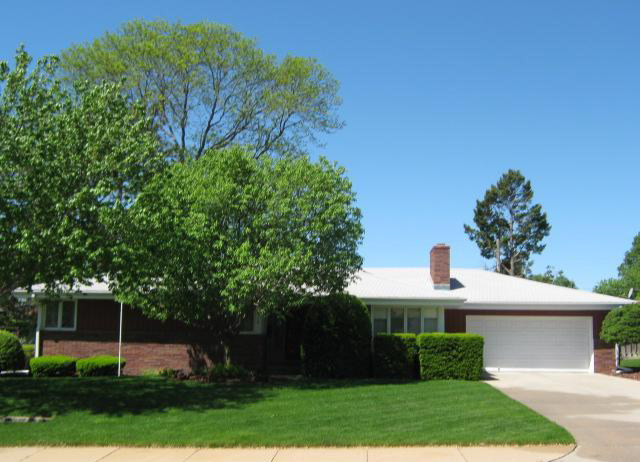
The concise addition has 72nd Street as an eastern border, Cass Street running south, 74th Avenue girding the west and Burt Street on the north side. Underwood’s catchline was “Every Lot a Scenic Spot.” Promoted for being outside of the city limits, meanwhile touted for its proximity “just west of Fairacres—Omaha’s finest residential section” and as being close to Omaha University (now UNO) and Underwood Grade School. This school was originally located at 78th and Cass Street, just across from Peony Park. The Underwood school also offered a high school until Westside opened in 1952.
And there, right on the corner of 72nd Avenue and Cass was Omaha’s Blandings’ Dream House replica. It was just like I had read–the Dream Homes were often positioned on a corner lot. Did this house serve to draw prospective homeowners to the area? It seemed fitting. It was positioned on a nice, visible perch.
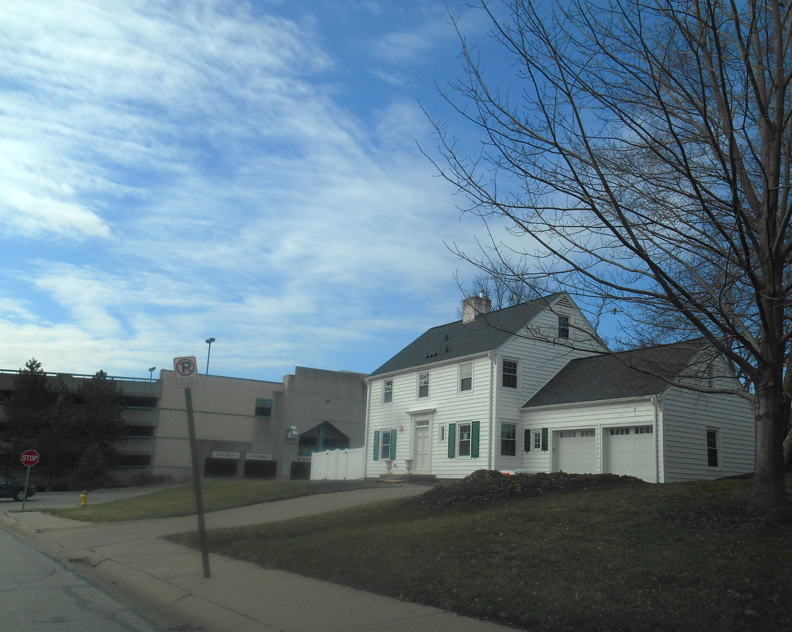
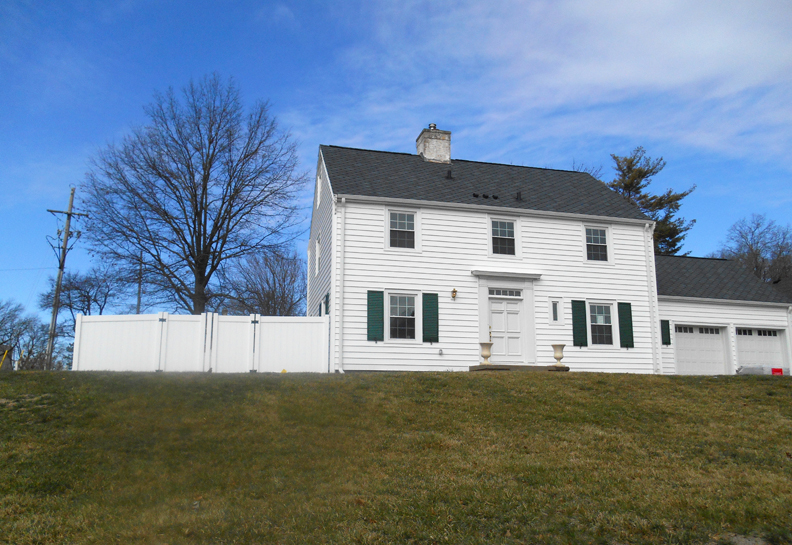
Why had I not noticed 502 North 72nd Avenue before? Perhaps the Google Map image to follow tells the story of what she has looked like in recent years.
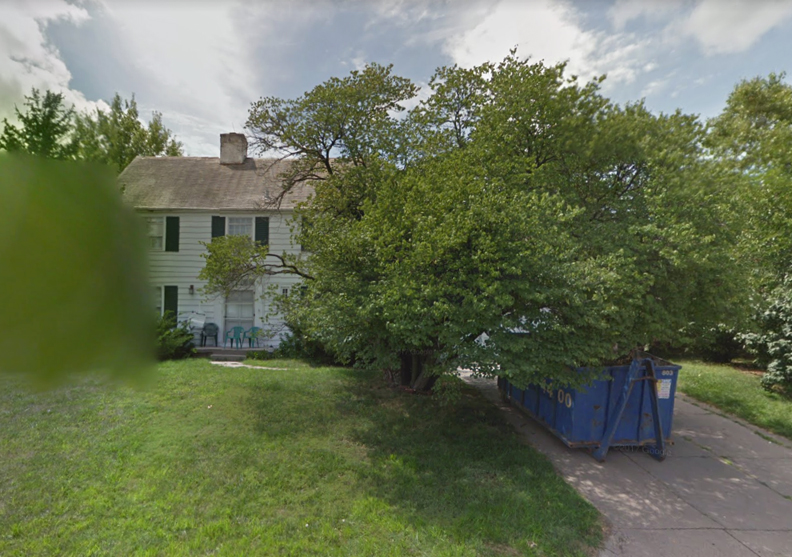
A bit shaggy and bashful….but workable! Good 1940s Bones, as they say.
Underwood Hills Early Years
The Schroeder family wisely purchased the forty acres just west of 72nd Street in 1947, then countryside. In fact, just outside of the City limits. They figured this would be an additional bonus for new home builders wanting to avoid City taxes.
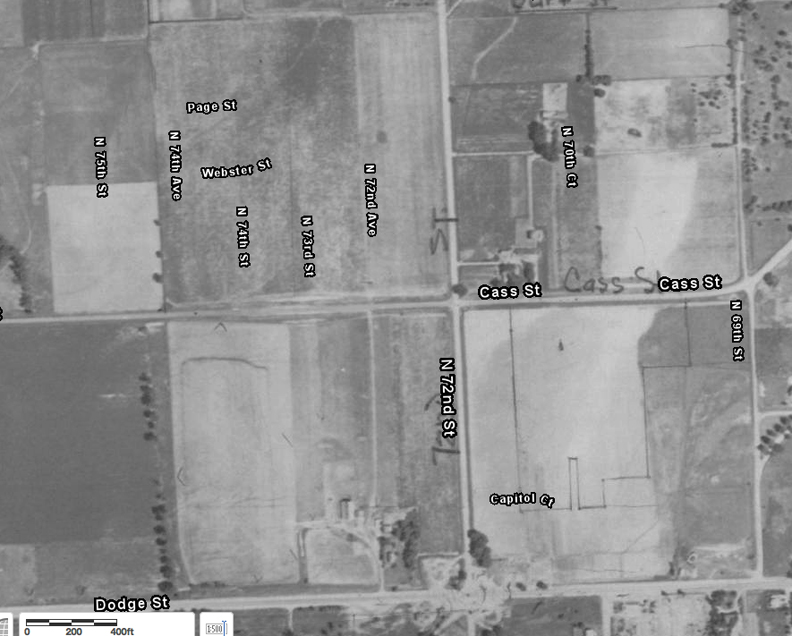
Here is an aerial of what the land at 72nd and Cass looked like in 1941. Image borrowed from the Douglas Omaha GIS site. For more information about this rural region, now considered Midtown, check out my other investigation Mysteries of Omaha: 1002 North 72nd Street on country living in the heart of town.
Underwood Hills Company was capitalized at 25 thousand dollars. Jesse L. Schroeder and his wife, Mildred Louise, along with son, Richard “Dick” Schroeder were incorporators and landowners. E. M. Rohrbaugh was the engineer for the new suburban addition. Rorhbaugh had laid out Dundee, Happy Hollow, Fairacres and County Club subdivision, previously.
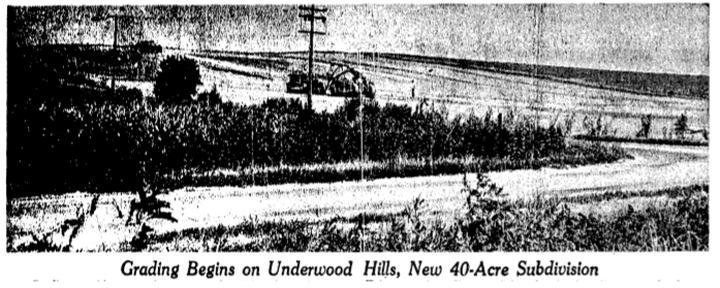
Image from the OWH. August 21, 1947.
“Grading machines are shown at work cutting down the slope on Underwood Hills, a new subdivision for medium-priced homes west of 72nd Street at Underwood Avenue. Grading began this week. The entire tract consisted of 40 acres, involving 144 lots, of which one-third of the area or 48 lots are being developed now. According to Schroeder Realty Company, developer, Underwood Hills will be a restricted community, featuring wide lots and rambling-type homes. The land is outside City Limits but the entire area is subject to City zoning ordinances. The camera is pointing northwest, with 72nd Street in the foreground.”
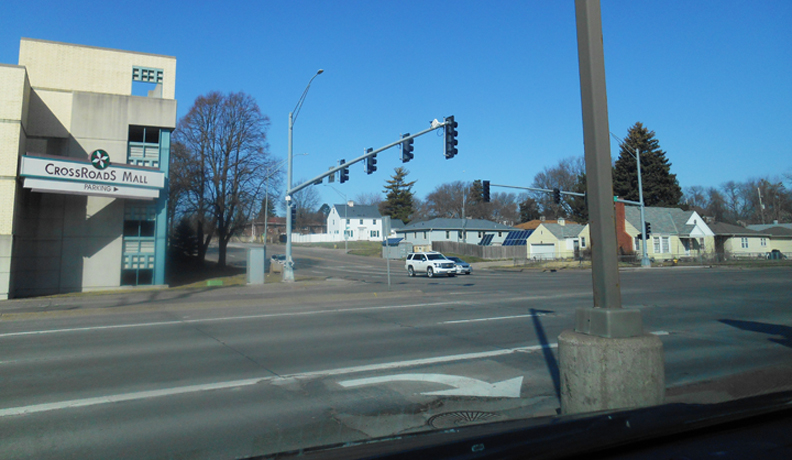
My image shows how the area looks today from the same angle. 72nd Street in the foreground. The white SUV is driving east on Cass Street. And there she is—the glowing white Dream House in the distance.
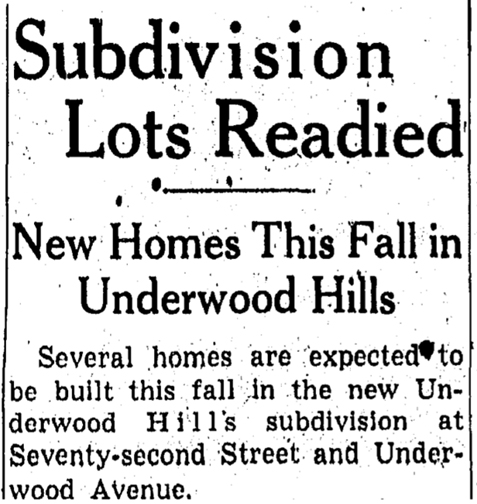
Image from OWH. August 31, 1947. Drumming up the excitement, the Schroeders’ had frequent press about Underwood Hills. But the addition really wasn’t ready until October of 1947, when the grading was completed and sewer installation began. 51 lots were to be developed in the first phase. The full plat would include 150 lots. An article from late April of 1948 said a “model house is being built in the southwest corner of the tract.” According to the illustration of the phase one subdivision map, this model would have been Lot 10, Block 3. 502 North 72nd Avenue. Was the soon to be Blandings’ Dream House also the model home for Underwood Hills?
The Dream House and the Veterans’ Organization
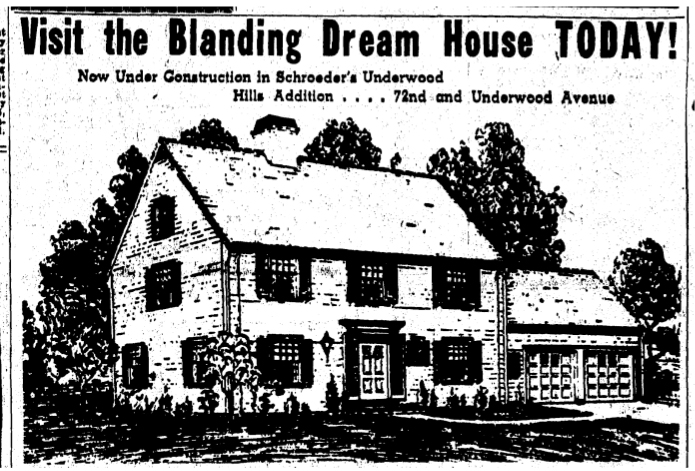
Image from the OWH. May 16, 1948. Finally, the ad I was dying to see. The Blanding Dream House advertising arrives. New Under Construction in Schroeder’s Underwood Hills Addition….72nd and Underwood Avenue. “Good Lumber furnished by Johnson Cashway. You’ll get a real thrill when you see the quality construction being built into the Blanding Dream House by the Schroeder Realty Company. Fine workmanship and top grade lumber were a must requirement for this fine home, now being constructed in co-operation with Selznick-International Pictures and under the sponsorship of the Voiture 206 and 40 and 8 Club of the American Legion.”
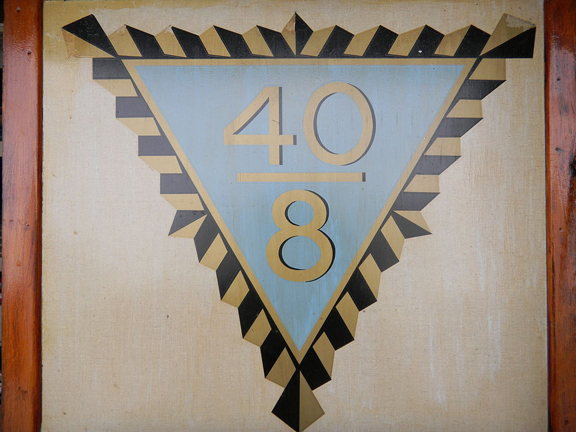
The Forty and Eight connection is an interesting one. In the 1920s when the American Legion was being created, a few Legionnaire leaders came up with an off-shoot club–The Forty and Eight. “The box car of the French railways, so familiar to American ground troops of World War I was chosen as the symbolic heart of the new organization, reading ’40 Hommes/8 Chevaux.’ The French railroad theme was applied to officer titles and organizational functions.” Omaha’s own Forty and Eight Club was at 3113 S 70th Street but I think this locale is gone now? I’ve only been to this veterans’ club for a few of their fabulous spaghetti feeds. Please update me if you know. But for our purposes, with regard to the Blandings’ Dream House, the elite Forty and Eight Club of the American Legion is how this home got built locally.
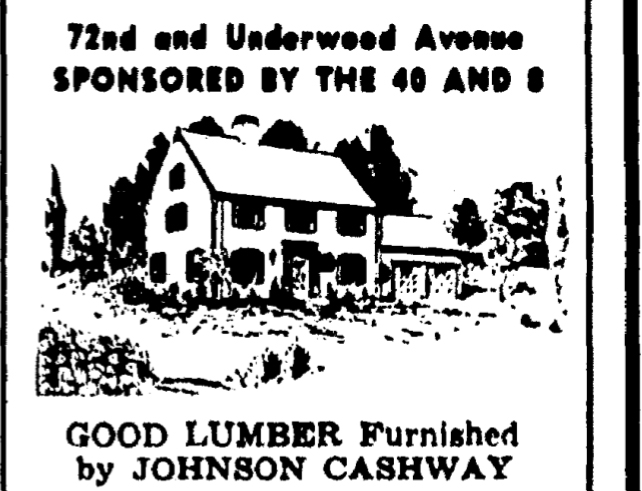
OWH advertisement from June of 1948.
In July 31, 1948 I found a real estate sale listing: Underwood Hills Co. had sold to Voiture Locale No. 206, Forty Hommes et Eight Chevaux: Lot 10 in the Underwood Hills Addition.” It was official. The veterans’ club owned the land.
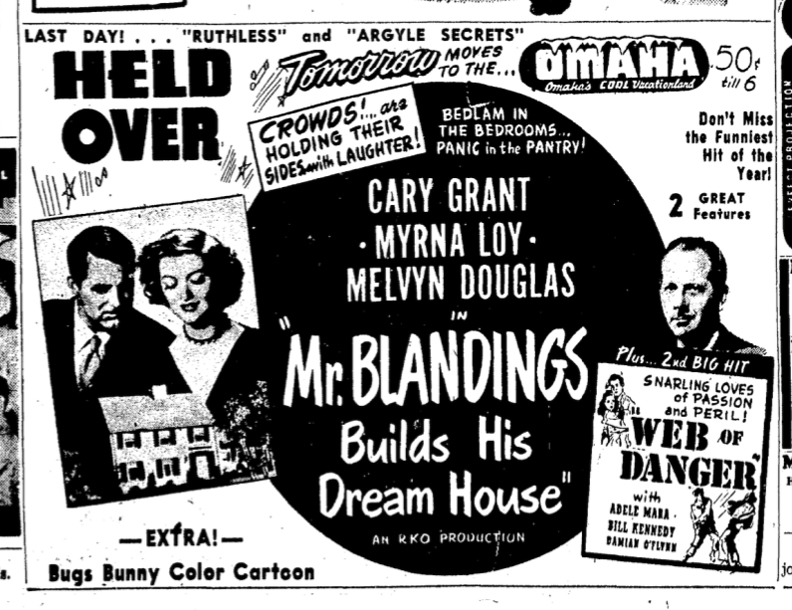
The Mr. Blandings Builds His Dream House movie now “Held Over” at The Omaha Theater. August 18, 1948 advertisement from the OWH. Doesn’t Myrna Loy look a bit like Bette Davis here? Love the icy drippings of the Omaha logo—to keep patrons chilled in the late summer. “Omaha’s COOL Vacationland” read their tagline.
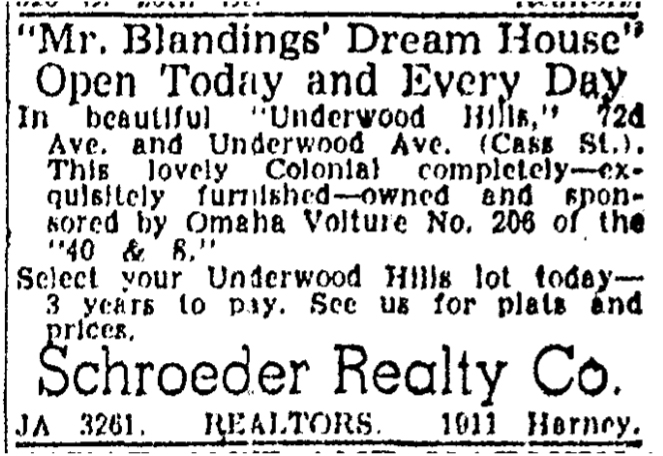
OWH article from September of 1948. The Mr. Blandings Builds His Dream House Omaha replica was finally opened for public viewing in September of 1948.
Side Note for those who like these Extra Special Details: 518 North 72nd Street was actually the first home completed in the Underwood Hills addition.
And the Winner Is…
An estimated thirty thousand people inspected the seven rooms and two and half bath Colonial after the Blandings’ replica home was completed and opened to tours. The American Legion’s 40 and 8 Dream House committee said the house cost about 35 thousand dollars with ten thousand dollars for furnishings. (There are varying accounts.) The veterans’ club estimated they would lose between five and seven thousand on the promotion.
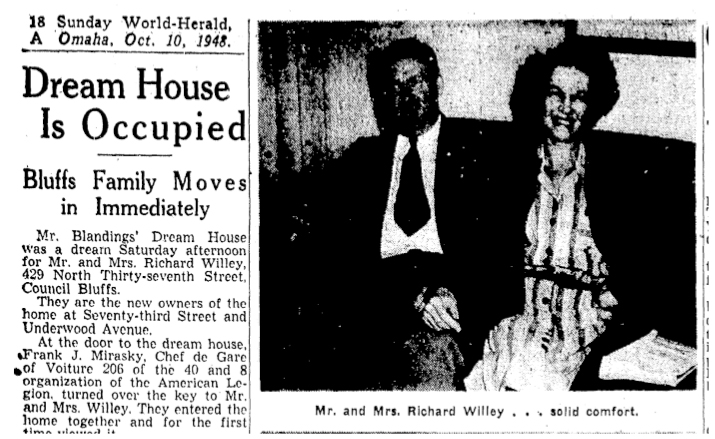
OWH image from Oct of 1948. In October of 1948 an excited Omaha audience held their collective breath as the 40 and 8 organization of the American Legion drew the winner of the Dream House. Mr. and Mrs. Richard Willey and their small daughter, Theresa, of Council Bluffs, Iowa were awarded the home. Interestingly, the Willey family operated “a tourist village” in Council Bluffs.
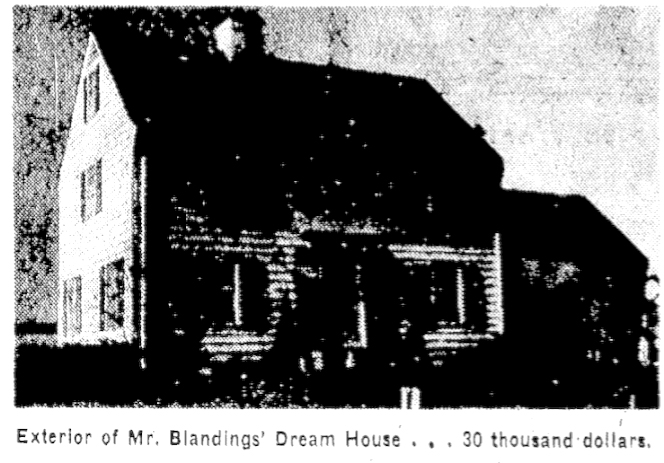
The Willeys pose in front of 502 North 72nd Avenue. Is this a dollhouse? I can’t see a thing but I guess I’ll believe it! The World-Herald wrote of the house back in 1948: “Finished in white, wide clapboard siding, it sets 40 feet back from the newly paved street on a lot 110 feet wide and 120 feet deep. It features remote control lighting, an electric range with dozens of buttons that light up in different colors when pushed and doorbell that announces visitors with a short concert of chimes. The all-electric kitchen contains an automatic dishwasher and garbage disposer. An interior decorator chose and placed the furniture. The house was ready for its owner in every detail, including ash trays, matches and cigarettes on the dining room table.” Oh my goodness. Boasting of laundry equipment, radiant heat, two tiled bathrooms, two-car garage and a finished basement–this would be a dream home to many of us in 2020!
Curiously in December of 1948, months after moving in, it was announced the Willeys had sold their Dream Home and furnishings to Dr. and Mrs. Michael Crofoot of 412 North Elmwood Boulevard. Let it be known that Miss Cassette is positive 412 North Elmwood Boulevard is a True, To Die For, Dream Mansion. It was a rather strange swap to be sure, all the way around. (More on that later.)
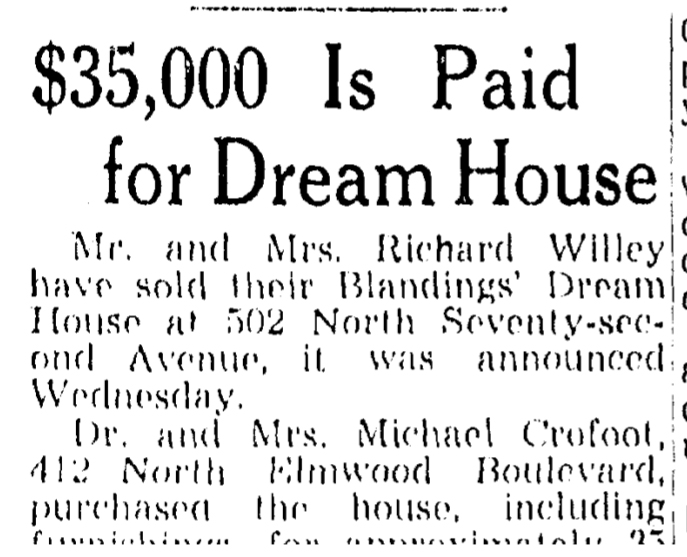
“’It’s such a nice house and we hated to leave,’ Mr. Willey said. ‘But we couldn’t very well live there and operate our business in Council Bluffs.’ The couple owns a tourist camp at 429 North 37th Street, where they make their home.” Huh? One would think one would have known that when they moved to Omaha. The last line of the quote makes plain, in my estimation, that the family kept their home in CB and that this was a fake move-in—with the secondary sale was planned all along. They won fair and square, I suppose.
The Crofoot Rabbit Hole
We had met Miss Mary Nash in an earlier My Omaha Obsession article: The Secret of Burt Street. In observance of good form, let us get reacquainted. Mary Nash married Lodowich Champlin Fitch Crofoot; the couple had children Edward, Virginia, Lodowick, David and Michael. Senior Crofoot, understandably, was forever known in the press as L. F. Crofoot. I have touched on this family in a number of other articles as they were quite well known in Omaha Society of the past. Upper Crust Pioneers, shall we say.
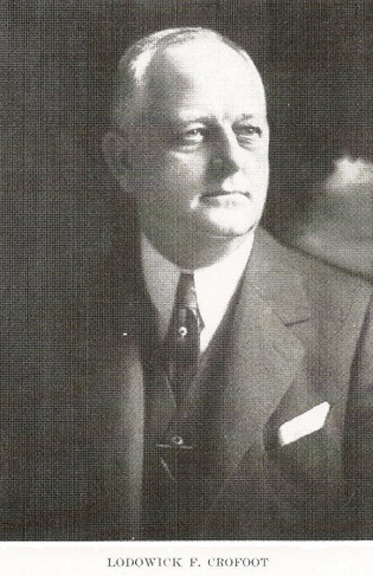
Lodowick Champlin Fitch Crofoot was a local attorney. From my favorite reference book, Omaha: The Gate City, and Douglas County, Nebraska, Volume 2 by Arthur Cooper Wakeley, I gathered L. F. practiced in his own firm of Crofoot, Scott & Fraser. The firm represented the Chicago, Milwaukee & St. Paul Railway Company in addition to the American Smelting & Refining Company along with other large corporate interests. He was also director of the Omaha & Council Bluffs Street Railway Company, director and vice president of the Hawkeye Portland Cement Company of Des Moines and director and treasurer of The C. B. Nash Company Investments of Omaha. His wife, Mrs. Mary’s father, Edward Watrous Nash was the first president of the American Smelting and Refining Company. It is all in the family, as it has always been. Intriguing Note: Mary was chairwoman of the executive committee of the local anti-suffrage movement, locally called the Nebraska Association Opposed to Woman Suffrage.
Young Michael Crofoot, the last of Mary and L. F.’s offspring, did extraordinarily well in his schooling at Creighton Prep, Phillips Andover Academy and Stanford University. He advanced on to Harvard Medical School, becoming a doctor in 1937. At some point Michael married Julie De Mane. During World War II Young Crofoot served as lieutenant in the Navy Medical Corps and was a veteran of the D-Day landing in Normandy. The Navy regrettably notified his family that he was missing in action for several days, after his landing craft was destroyed on the beach. But Michael lived to return to Omaha and experience what sounds like in print, to be a beautiful, generous life as a pediatrician and family man. He would join the Nebraska University medical faculty shortly after World War II, become a member of the American Academy of Pediatrics. He would go on to found and direct the Camp Floyd Rogers for Diabetic Children, his passion for thirty years. Dr. Crofoot was also medical director of the Hattie B. Munroe Home and professor emeritus of pediatrics at the University of Nebraska Medical Center. Dr. Michael and wife Julie would have children Julie, Lodowick the III, David, Charles and Edward, and Michael Jr.
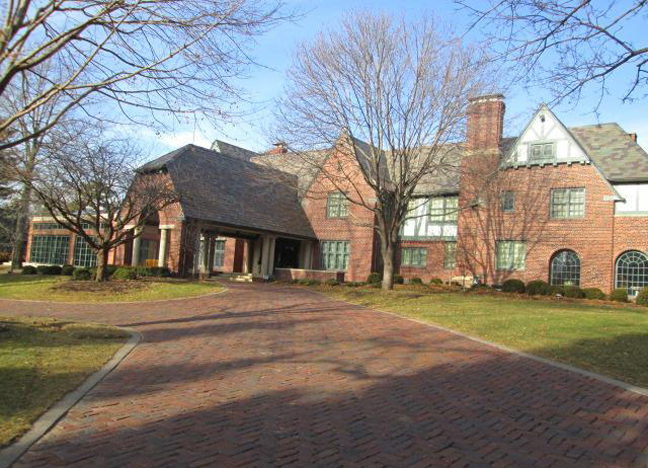
When I happened upon L. F. Crofoot’s obituary from 1950, I was reminded of the 412 North Elmwood Road address, listed as his place of death. This address was also registered as Dr. Michael’s home, when he bought the Blandings’ Dream House. This great Fairacres mansion was not actually Dr. Michael Crofoot’s home, it was his father’s home. A sprawling estate, it is plausible that many Crofoots lived within those walls. It all made great sense to realize the Dr. Michael Crofoot family was wanting a home of their own, of which to define themselves. For the record, a few short months after L. F.’s death, the Swanson family acquired 412 North Elmwood. Mr. and Mrs. Gilbert Swanson, Gibby, Jay, Patsy and Carla moved into their new digs straight away. Check out the Swanson Tower case for more details.
Their Perfect Choice
The point…what was the point? The purpose of all of this Crofoot rambling is to illustrate that Dr. Michael came from not so humble of upbringings. The fact that Michael and Julie Crofoot chose this great, albeit, simple home to raise their children spoke volumes, certainly considering the silver spoon and all. The couple wanted suburbia. They wanted modern. They wanted something different. This was probably one of the best gifts Dr. Michael could have given to his family—an unassuming home to make their own. By all accounts, the Crofoots truly lived in 502 North 72nd Avenue. Dr. Crofoot planned great things for Omaha and served his community from this humble foundation and it sure wasn’t hard to find the Crofoot children’s many adventures documented in the papers. 502 North 72nd Avenue played hostess to it all.
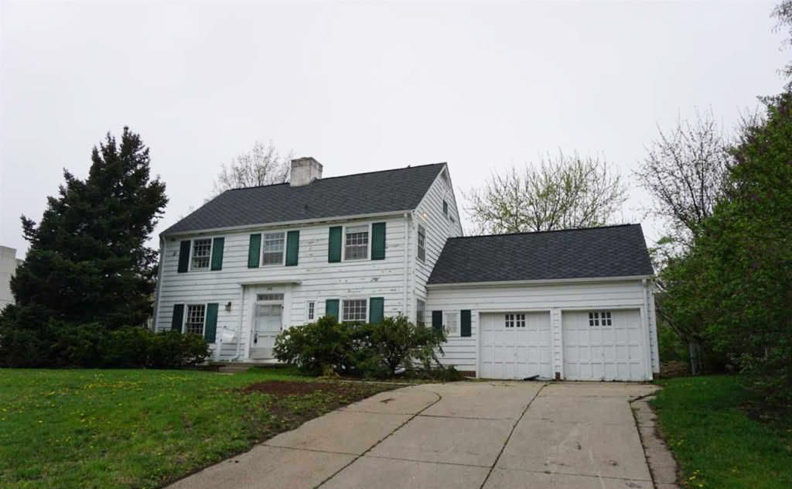
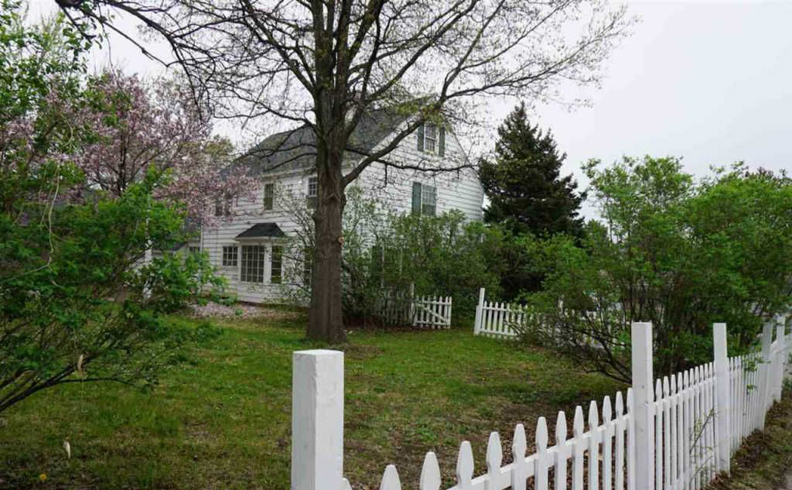
Photographs borrowed from the house’s 2018 real estate listing through Keller Williams.
I was happy to see Mrs. Crofoot making headlines when she Raised Cain about the 1986 Crossroads expansion. The proposal for the five-level parking garage (eventually it was six stories) at Crossroads Shopping Center drew opposition from Underwood Hills neighbors during City discussions. The neighborhood residents said its location on the northeast corner of the site, across from Cass Street, would be an intrusion into their single-family neighborhood. Mrs. Crofoot and others also said a covenant reached in 1959 guaranteed that when the Crossroads Shopping Center was built, it would provide a 30-foot landscaped buffer along Cass Street. City officials would later respond that the buffer agreement expired in 1974. They did agree to create a buffer along Cass for the Underwood Hills neighbors and yes, I do observe some trees dotting the remnants of the Crossroads perimeter. Ultimately it is difficult to hide a six story concrete parking garage. And there was Mrs. Crofoot fighting for her rights and those of Underwood Hills. I had to smile. She was quoted, “In 1948, we bought our home outside the city limits for fresh air. If we wanted to live downtown, we would have moved there.”
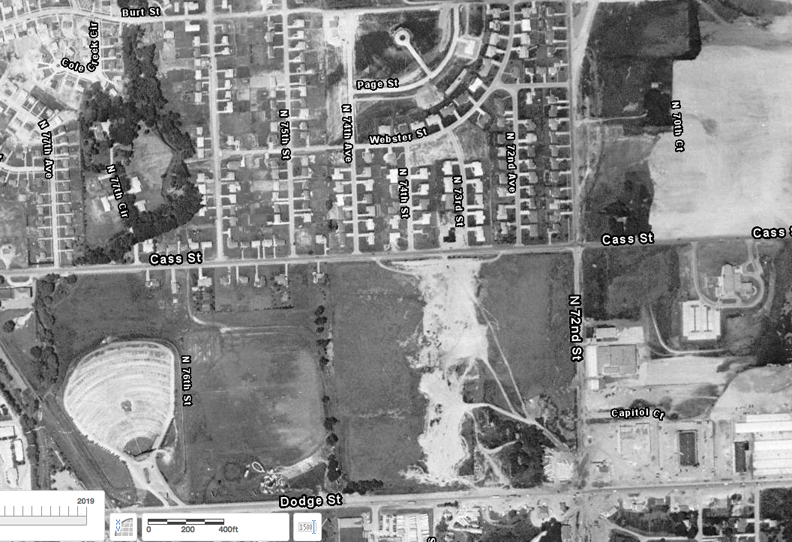
Aerial of the Underwood Hills Addition from 1955. Image borrowed from the DOGIS site. From my survey of the Underwood Hills Addition, the majority of the homes would be built in the early fifties but the addition upbuild spanned 1951-1963. The three earliest homes, all Colonial Revival style, perhaps copying the Blandings replica, were built from 1948-49. The aerial shows a vacant Crossroads lot. Underwood Hills is filling in and there’s that cul de sac I had mentioned. Oh look…it’s 76 West Dodge Drive-In!

OWH February of 1982. Dr. Michael’s obituary.
I believe The Blandings Dream House was in the Crofoot family until a few years ago. I might be wrong on that account but due to the Coronavirus, all of my favorite public spaces are closed and I can’t find out definitively…yet. Lori Krejci bought the home with intentions of renovation and has steadily worked on it for the last year. If the home is anything like her other projects, it will be a top-drawer affair. I cannot wait to hear who the next family to move into this Dream House will be.
Some Fun Match-ups
Because I cannot resist, Mr. Blandings’ stills or movie promos coinciding with a similar photo from the last 502 North 72nd Avenue sale.
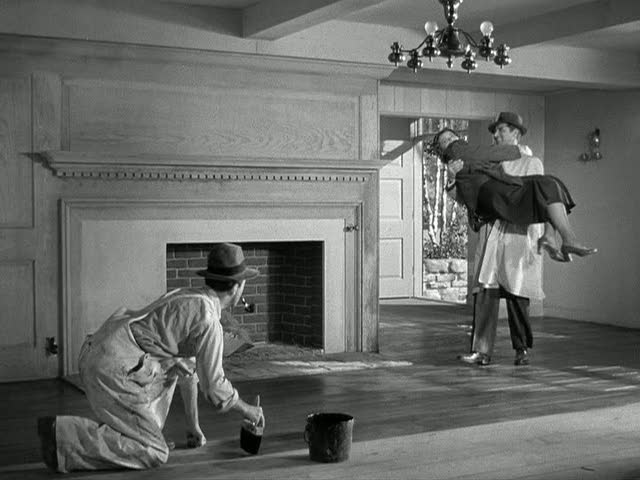
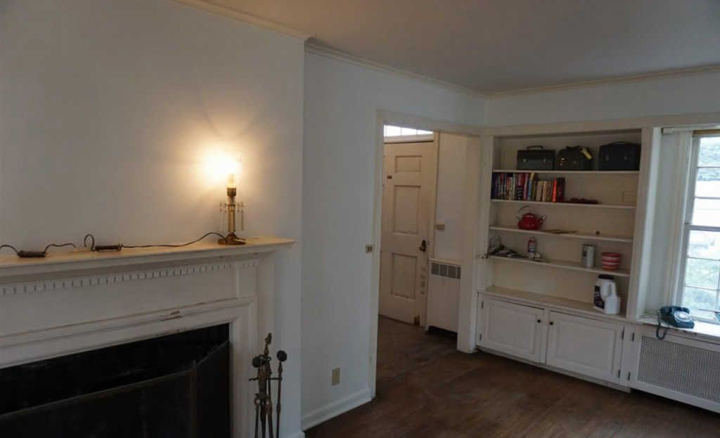
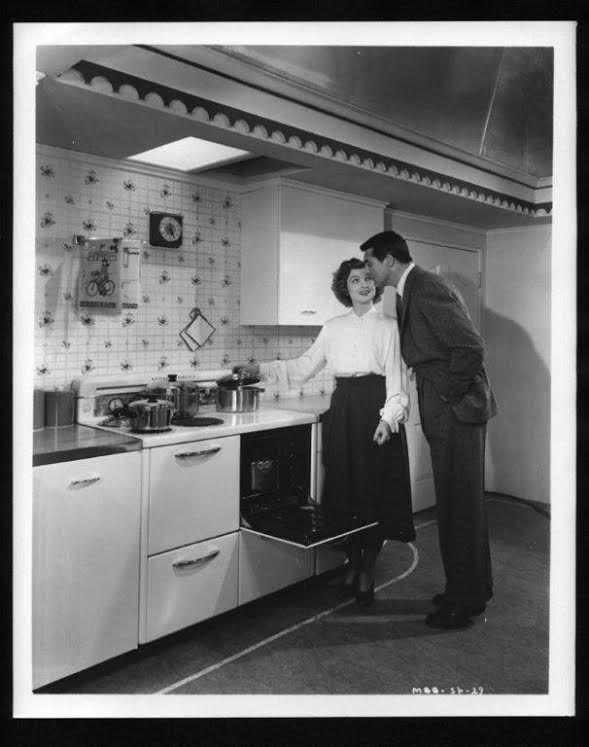

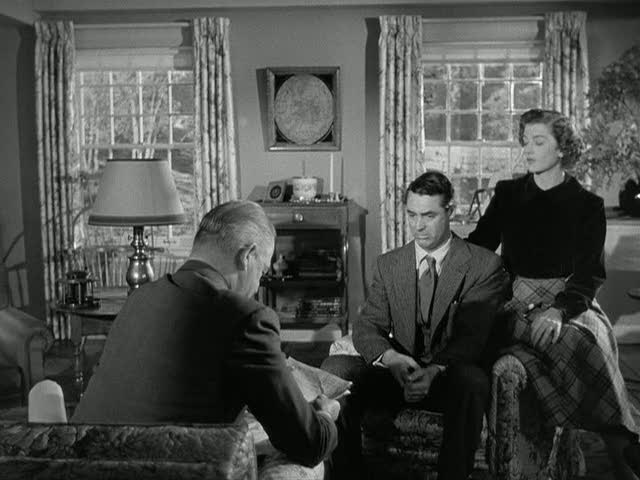
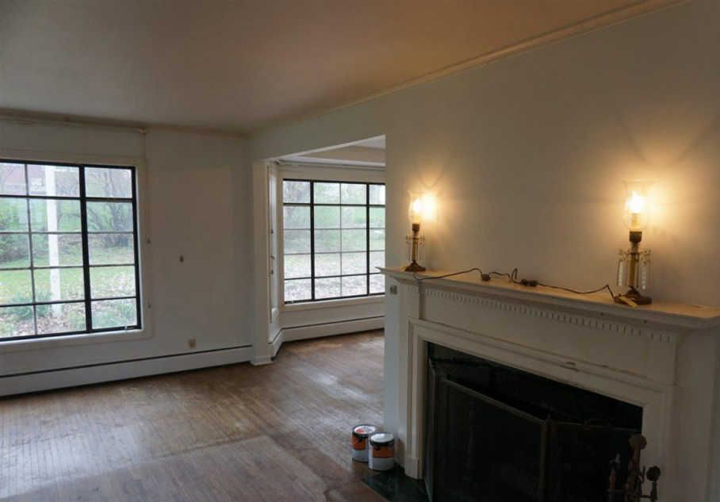
“Mrs. Blandings said to herself, ‘It needs someone to love it, that’s all.’ She flashed a glance at her husband, who flashed one back at her.”
Thank you so much to Barb Naughtin and Lori Krejci, without whom there would be no story.
I welcome your feedback and comments on the Blandings’ Omaha Dream House, Underwood Hills, the 72nd and Dodge Street area or Cary Grant. Let us hear from you. Please share your additional clues to the story in the “Comments,” as we know more together. Everyone would love to read what you have to say and it makes the sharing of Omaha history more fun.
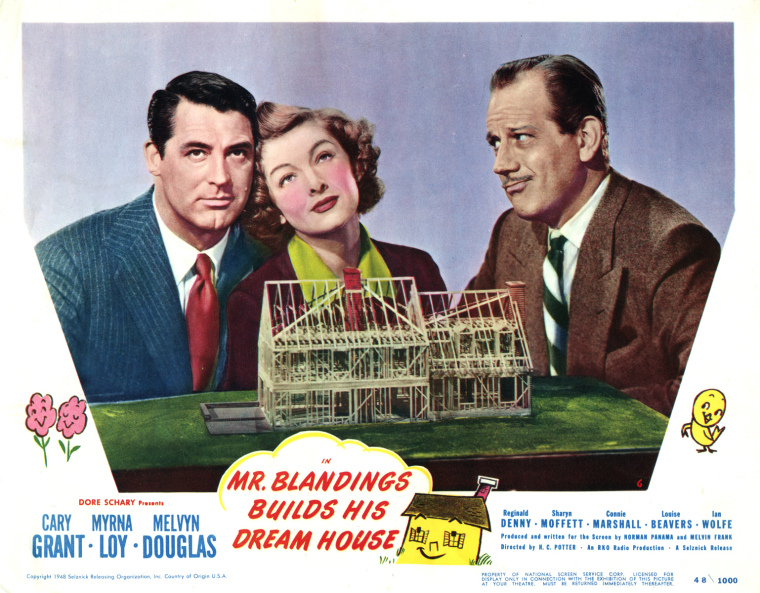
You can keep up with my latest investigations by joining my email group. Click on “Contact” then look for “Sign me up for the Newsletter!” Enter your email address. You will get sent email updates every time I have written a new article. Also feel free to join My Omaha Obsession on Facebook. Thank you, Omaha friends. Miss Cassette
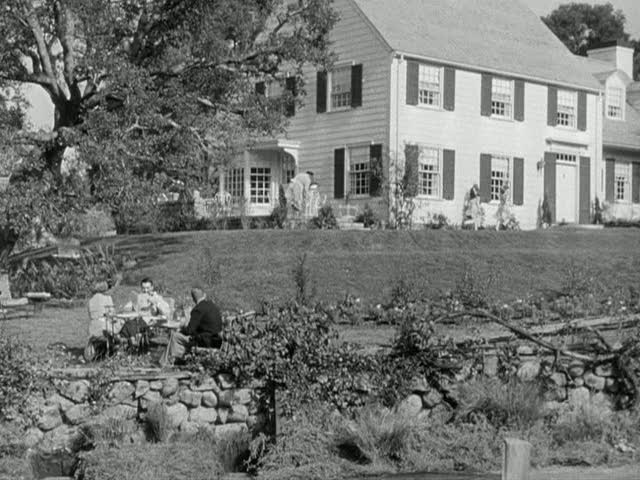
© Miss Cassette and myomahaobsession, 2020. Unauthorized use and/or duplication of this material without express and written permission from this site’s author and/or owner is strictly prohibited. Excerpts and links may be used, provided that full and clear credit is given to Miss Cassette and myomahaobsession with appropriate and specific direction to the original content.
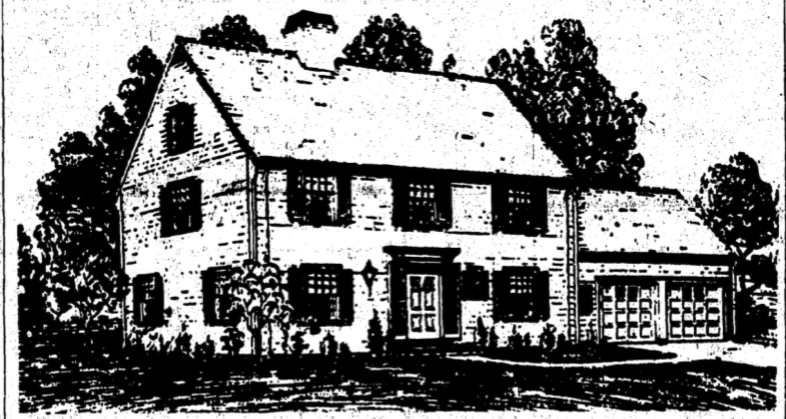
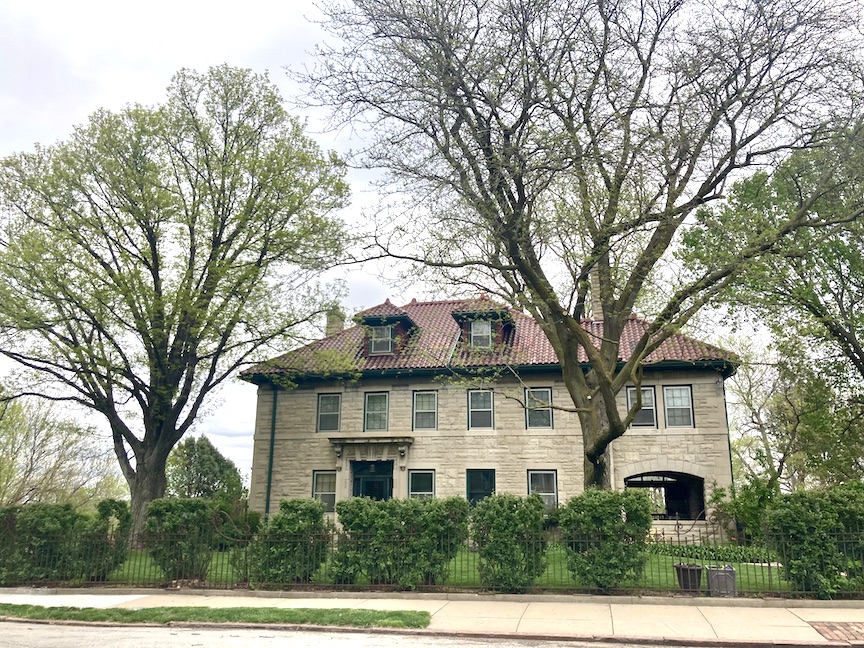
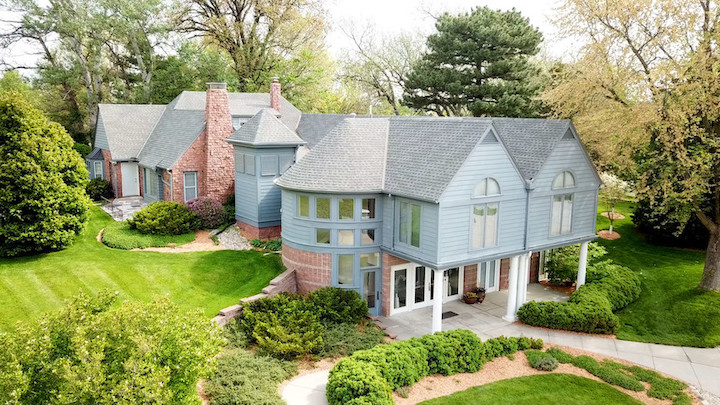
Another fabulous story! Thanks for all your work and the fun presentation!
The movie is one of my favorites. I can’t imagine how often I’ve driven by the Omaha house.
Now I’ll drive by and smile.
I was still wondering if you might be interested in doing a piece on Davidson’s Furniture Store at 8001 West Dodge Rd. A once gorgeous Deco style three story building that had a huge well known lantern that shone off of its corner. I grew up in that store and could fill in gaps. I knew the Davidsons very well, and my father was the store’s manager for forty years. It furnished Swanson Towers, Larry Meyers of Countryside Village’s Home, and many many others. Just a thought. I don’t live in Omaha any more but would be glad to help. Love your stories and remember almost all of the places you visit. Feel free to drop me a line anytime. Dave.
Oh and one other note from me Dave. The house kitty corner to the blanding house on 72nd ave and Cass was my Grandfather’s house. You could see that house out his back yard windows.
I was fascinated by the article and read the entire article. I’m a teacher of adults who are studying English and are not from Omaha
I include information about Omaha
I was raised in South Omaha and look forward to articles about my part of this great city. Can I?
I was just thinking about this house two days ago while driving by a home that reminded me of this house. I grew up in Benson doing a lot of activities at Peony Park. I have driven by this house many times. When my mother was in the car with me, she retold the story of Blandings Dream house. I have not lived in Omaha since 1964 (I am old). I grew up in the Sprague home in Rosehill addition.
I love your stories as I am also a lover of arcitecture and how it fits into our history
So wonderful to see a photo of my dear pediatrician Dr. Crofoot! He was such a kind and gentle man, and very patient with my nervous first-time mother. Thank you so much for bringing me the gift of a favorite memory during this uncertain time.
Thank you once again for a story on property in our area with such an interesting history! Years ago, I had been told that particular house was a “Brandies Dream Home” of 1948; oh well I guess the source was close, anyway! I’ve had the pleasure of passing this house in recent weeks, and noticed all the restoration work it has gone though. An amazing job, and SO happy the current owner decided to do a restoration of it! Homes of this style & structure just aren’t built any more. I always knew that area was early post WWII, but was unsure where it dated. A friend owns a home there built in `49, so I knew it dated back that far.
Ms. Cassette, another home I would love to learn the history of, is the one right on the corner of 72nd St. & Cass–the yellow one with the garage facing Cass. I remember way back when the breezeway between the garage & house was wide open. It’s almost lost it’s trees, but the basic home remains.
What a great read! I’ve had this on my task bar for 3 weeks, I’m so glad I finally got to read it today. Thank you for taking my mind off this crazy world for a bit! Now off to see if I can find the movie.
I love this article. i’ve driven by the house countless times and never knew the connection. I look forward to your articles and also hope the libraries and your other sources of information will open soon.
Do you have the book The Story of Omaha printed in 1923 ? It has a lot of early info. I would be happy to loan it to you. It was given to my great aunt from my great grandfather
Hi Suzanne! Was this the Alfred Sorenson book or another one? Thanks
I’m from the Portland OR area, and I know the Cedar Hills house (actually in Beaverton). I always loved looking at it as I drove past it~I love that movie and knew it was a Blanding’s house (although, I thought the movie had been filmed there). I even worked for Meier & Frank, who sponsored the house, for a time. Thank you for this Omaha story~I like learning about Omaha!
Thanks for the story about the home that I and my siblings grew up in. Sara Sharpe’s comments about my father brought tears to my eyes. It seemed like a big house when I was little, but with six kids it could feel not big enough. Lori Krejci the new owner did an amazing job of restoring the house after it had fallen into terrible shape. The family history you mentioned was a welcome bonus. Again, thank you for your interest and fine story. Charley Crofoot
The Blandings house in Bakersfield, CA has been our home since 1997. If you would like some photos and history it would be my pleasure to share them…MM.
I just found this story after reading about Blanding’s Dream House and remembering the Crofoot family and the house at the end of our street. I was born and grew up in the home you mentioned at 518 N. 72nd Ave., the first home to be completed on the street (which I didn’t know). My great grandfather was the founder of the Alfred Bloom Company, a millworker company, and provided all the millwork for our home. Great memories of our close neighborhood – Playing a lot of games of “horse” in the Crofoot driveway. Dr. Crofoot was our pediatrician for many years.
I wonder if in your research you ever came across a house in Council Bluffs off Madison Avenue where a new house was built around an older house. My Dad lived there in the 1940s and pointed it out to me once a long time ago. I’ve been trying to find it but no luck. I love Mr. Blandings because it reminds me of a house that my husband and I bought in Iowa. We did some remodeling and an addition and had adventures like in the movie. The funniest one was when the workers installed the window framing in my new kitchen sideways and they had to be redone. Unfortunately, my husband died of cancer before it was finished. I had to sell it and move away when I relocated for another job. That’s when the housing market crashed and I had two mortgages. I bought a lovely little Cape Cod in another town and fixed it up so cute. Now someone else has it and they ruined it by painting it charcoah gray with a bright green door and a huge fence for dogs in the back yard. The neighbors are telling me how horrible it is now. I retired and moved away.
Dr. Michael Crofoot was my pediatrician, back in the day. I still frequently recall my mother talking about the house, especially when driving near that corner.
As I began to read your article I wasn’t sure if you would know of that specific info, and began to doubt it in reading about the original owner.
GREAT ARTICLE! Thanks!